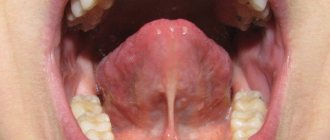Quiz for everyone - answers to all levels of the game.
We begin to compile answers for all levels for the Quiz game for everyone. This is an educational and entertaining application for phones, smartphones, and tablets with the Android system. Hints, answers, solutions for all levels and tasks. Any help in passing the game “Quiz for everyone” (What? Where? When?). Quiz question “What? Where? When?" is given in text format, but it contains missing words indicated by numbers. Photographs are used as clues for composing questions, from which you must correctly select the one that matches the missing word. In addition to photographs, there is also a table with syllables, using which you can get a few more hints. When the question is drawn up, all that remains is to give the correct answer to it. If the question is guessed correctly, then the game moves to the next, more difficult level.
If it is difficult to complete this or that task, then you can find the answers to the game “Quiz for Everyone” on our game portal Branto Ru.
Amazing narwhal tooth
There are many amazing teeth in the animal world. But we will only talk about the largest tooth among modern representatives of the fauna.
The first place in the size of teeth, or rather, just one tooth, is occupied by a marine mammal of the cetacean family, narwhal. This inhabitant of the northern waters of the Arctic and Atlantic oceans is proudly called the sea unicorn. These whales reach impressive sizes - up to 4 meters in length, and the male weighs up to 1.5 tons.
Interestingly, they only have two teeth. At the same time, their left one develops into a spirally twisted tusk up to 3 meters long and weighing 10 kilograms, while the right one is underdeveloped. The purpose of this massive device still raises many questions among zoologists today. This is not a weapon of defense or attack, it is not used to break through ice. It is assumed that this is the sensitive organ of the narwhal - after all, it is penetrated by many tubes, inside of which there are nerve endings.
Musk deer
Externally, musk deer are very similar to deer, but unlike them they do not have antlers and have long fangs. With an average size of an animal weighing 11-18 kg and a height of up to 70-80 cm, they grow fangs 7-9 cm long. Like many representatives of the animal world, males are larger than females. They use their fangs for tournament battles in the fight for place and possession of the female. During a duel, male musk deer often fight to the death. During pursuit, they try to strike the spine with their front legs and stick their sharp fangs. Long fights end with one of the opponents being knocked to the ground and killed by blows from hooves and fangs. Also, long teeth allow you to get food from hard-to-reach places.
Musk deer often live alone or form a herd of no more than three heads
The evolution of our teeth
The teeth of our ancestors, who lived 100 thousand years ago, were twice as large as the average teeth of a modern person. This was explained by biological necessity - rough plant foods and raw meat required just such a chewing apparatus.
Over time, human teeth decreased, according to anthropologists' calculations, by 1% every thousand years. In addition, they not only became smaller, but also changed their purpose. Our largest tooth is the first molar on the upper jaw. The canines have lost their function of holding food and have also become smaller. But not all people grow third molars (wisdom teeth).
Dinosaurs
The largest teeth in the usual sense of the word belong to long-extinct dinosaurs. Once upon a time these giants inhabited our planet.
You can also read:
The most terrible shark in the world
Some representatives were of impressive size, which is confirmed by the elements found by archaeologists during excavations.
For example, a Tyronosaurus tooth was found in South Dakota. Its size amazes not only people, but also scientists. The length of the tooth from root to end is 33 cm. Officially, this is the largest tooth of extinct creatures that inhabited our planet, found by scientists.
Another unique discovery occurred in Portugal. A dinosaur tooth measuring 12.7 cm was found, which once again confirmed that our planet was once inhabited by huge predatory lizards. And these are not isolated cases; a tooth measuring 10 cm was also found in Spain.
According to scientists, the owner of this tooth - an allosaurus - was of average size among its relatives, and this means that the found tooth is far from the largest, and scientists still have many more discoveries in this area.
The sharp and strong teeth of dinosaurs easily broke bones and tore flesh.
Large teeth in humans - normal or pathological?
The size of teeth is in most cases determined genetically. If a child inherits the elongated and large crowns of one parent and the small size of the jaw of the other, then his units may appear disproportionate. Moreover, if large teeth do not lead to displacement, twisting, growth retardation of other units, speech defects or other problems, this is not a pathology. In addition, tall people tend to have larger teeth. Large molars are more common in children - because with age, the enamel tends to wear off.
The condition when a person develops abnormally large units is called macrodentia in dentistry. This pathology is hereditary and develops when two dental follicles grow together.
Olive oil
Due to its high content of oleic (monounsaturated) acid, olive oil is considered simply miraculous. It has healing properties. For example: to eliminate eczema, carefully rub the oil into reddened areas of the skin. An excellent preventative against skin inflammation is a bath with 100 ml of oil and 500 ml of milk.
How do Germans get rid of illnesses?
When it might become a problem
If large teeth do not have enough space to grow, they curl and go beyond the boundaries of the dentition. This leads to the formation of an incorrect bite, which is no longer as harmless as an unaesthetic smile. Malocclusions lead to disturbances in the functioning of the digestive system.
Sometimes teeth can become enlarged due to gum disease - this is a serious pathology that leads to the development of cervical caries and tooth loss.
Large teeth can cause speech defects, and if psychological problems are added to this, the person becomes uncommunicative, withdrawn, and constrained. And this is a direct path to depression.
Black pepper
As you know, you knock out a wedge with a wedge, and a hiccup with pepper! This physiological reaction of the body cannot be called dangerous; it usually goes away on its own. But sometimes hiccups can be painfully long-lasting. In this case, it is recommended to smell ground black pepper. The alkaloid piperine contained in it will cause a “defensive reaction”, and the hiccupper, by sneezing, will get rid of the hiccups.
How do Germans get rid of illnesses?
Big or not?
How can you tell if your teeth are big? Dentists have developed relative standards for the teeth of the average European. The central upper incisors are normally 9-13 mm long, and the lateral incisors are 2 mm shorter. The normal ratio of width to height of a tooth is 1.25%.
A person is diagnosed with macrodentia if the size of the dental crowns exceeds the norm by 1.5 times. At the same time, large baby teeth in a child are a reason to contact the dentist and check the dental follicles for fusion.
On the land
Living deep in the tropical forests of South America, the giant armadillo (Priodontes maximus) tops the list of the toothiest land mammals. It has 74 teeth. This number may not seem very impressive, but it's a lot for mammals, which are actually some of the least toothed creatures on Earth.
Egg-laying mammals such as the platypus have no teeth at all. And marsupials, such as opossums, have about 50. Humans have a measly 32 teeth. In this context, the giant armadillo is definitely an anomaly.
Most mammals are heterodonts. This means that their teeth are shaped differently and are complex, allowing precise interaction between the upper and lower jaws. This allows mammals to thoroughly grind their food, which allows them to absorb more energy and nutrients.
Russian software will be installed on Apple iPhones from April 1
Fashionable bun for short thin hair: three clever effective ways
“Let the children grow up first!”: why people put off apartment renovations
Fewer teeth means that nature has focused on very precise types of contacts and interactions between opposing teeth.
Correction methods
Modern dentistry offers several ways to solve the problem of large teeth. Only a professional doctor - a dentist or orthodontist - will tell the patient what to do and whether it is necessary. The following techniques will help correct the size of teeth:
- Grinding with a special machine can grind down the enamel and give the teeth the optimal size and shape.
- If necessary, it is possible to correct teeth with restoration using a modern composite.
- If it is not possible to sharpen the teeth, you can build up the adjacent teeth using ceramic onlays (veneers, lumineers).
- In some cases, large teeth are just the consequences of an incorrect bite. This is corrected with braces.
- As a last resort, you can resort to removing the tooth and replacing it with an implant of the required size.
Sometimes it's beautiful
Large, healthy teeth give a person a more youthful appearance. Aesthetic features often become a calling card and a sign of individuality.
Would Hilary Swank (pictured), Julia Roberts, Anne Hathaway become so popular if their smile was “like everyone else’s” - after all, it is this that gives them that piquancy and charm for which their fans love them so much.
So before you give yourself a standard smile, think - maybe it’s your imperfect teeth that are the highlight of your appearance and make you different from others.
Vertical symmetry and midline.
The smile line runs along the cutting edges of the upper front teeth (shown as a solid line in the photo) and should ideally follow the curve of the upper edge of the lower lip (shown as a dotted line in the photo), i.e. be convex.
A line passing through the center of the face should pass exactly between the central incisors of the upper jaw. The discrepancy between these lines causes a feeling of disharmony even with a quick glance at your smile from the outside. In this case, it is not at all necessary that it also passes between the central lower incisors.
In pursuit of unusualness
But some people want to stand out so much that they go to extreme measures. Popular in the last decade, vampire-like fangs have become part of a certain subculture.
One of the cosmetic rejuvenation procedures, for example, involves increasing molars. This changes the bite, lengthens the face and leads to a visible reduction in nasolabial folds and correction of the facial contour.
But such vampire fangs did not bring joy to the Chinese boy Wang Penfei. In 2012, his fangs grew and his growth slowed. The boy became withdrawn and aggressive with peers who were whispering behind his back.
The longest fang – 36.7 mm – was removed from an 18-year-old Indian in 2017. It turned out to be 4.7 mm longer than what was already included in the Guinness Book of Records. For comparison: the average size of a human fang is 20 mm.
Bouillon
For loss of strength, flu and other ailments, the list of “healing” dishes in Germany is headed by chicken broth cooked over low heat.
Spices are added to the broth: cloves, peppercorns, bay leaves, parsley roots, onion, and, if desired, a small piece of ginger. A favorite German chicken broth soup with thin, homemade noodles. Author: Inga Vanner
Under hypnosis at the dentist
Watch video 02:16
Amazing teeth
The teeth may not only be large, but there may be many of them, or they may not be where they should be.
Thus, 17-year-old Ashik Hawaii (India), who suffered from a rare pathology - odontomy, was included in the Guinness Book of Records. These are benign formations of 232 teeth. All his extra teeth were removed because they could lead to problems with swallowing, digestion and facial swelling.
But in the state of Maryland (USA), a tooth was found in the brain of a 4-month-old child. The strange location was caused by a pathology of embryonic development and led to the formation of a tumor. It was removed and the child feels fine.
Stephen Hirst (Great Britain) began to grow a tooth at the age of 47, and not in his mouth, but in his ear. And today it remains a medical mystery how the tooth follicle ended up in such a place and what stimulated its growth.
Everyone knows that children are born without teeth. But here is another record holder from the Guinness Book of Records - Martha Matoni from Kenya. In 2010, she gave birth to a son with a full set of baby teeth - all 28 teeth were already present in the boy’s mouth.
Mustard
Few people know about the benefits of mustard plasters in Germany today. It is also rare for Germans to steam their feet with mustard powder. Mustard is better known here as a remedy for... heartburn! It sounds paradoxical, but a teaspoon of hot mustard, “taken” after a meal, calms the stomach. Mustard oil contained in mustard improves the functioning of the gallbladder and liver, preventing the occurrence of heartburn.











